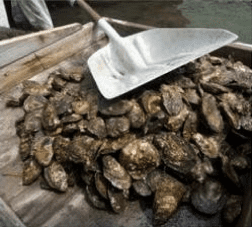

by Adriana Lopez
The expression Happy as a Clam€ comes with new meaning as hepatitis A virus has been detected in clams, mussels, and oysters in markets for human consumption. As bivalve shellfish are excellent bio-accumulators of contaminants and chemicals, it is no surprise that they also harbor waterborne viruses such as hepatitis A in areas with poor sanitation. Since hepatitis A virus is spread via the fecal-oral route, food-borne outbreaks due to ingestion of shellfish harvested from polluted waters have not been uncommon.
Despite development of an effective vaccine against hepatitis A virus, it continues to be a serious disease worldwide. In developing countries, access to healthcare and vaccination may not be available and many remain susceptible to infection. Eating raw or undercooked shellfish may pose a serious food safety threat to those unvaccinated in the event the mollusks are infected. Though many people have inapparent infections at a young age and acquire immune memory to hepatitis A, infections in adults can be quite severe and have led to death in some instances. While hepatitis A vaccination has been routinely administered to children in developed countries, anti-vaccine sentiments and public complacency have led to decreased childhood vaccination of hepatitis A. Though herd immunity* will likely protect susceptible individuals in developed nations at present, potential for outbreaks in the future is greatly increased if people continue to refuse vaccination and shellfish suspect to contamination are imported/shipped to market. As such, the U.S. Department of Agriculture (USDA) is considering different approaches to ensure the safety of human health in shellfish consumption.
One of the most promising techniques being studied by the USDA in regard to hepatitis A contaminated shellfish is known as high pressure processing (HPP). This commercial technology is already used for processing of several products in the food industry and demonstrates potential for inactivation of hepatitis A virus in shellfish. In laboratory tests, HPP treatment of 60,000 pounds per square inch of pressure for five minutes exhibited inactivation of 99.9% of hepatitis A in oysters subjected to the pathogen. Since human hepatitis A virus strains are unable to replicate in the tissues of contaminated shellfish, virions damaged or inactivated by HPP processing are unable to replicate and repair themselves to restore infectivity. However, since shellfish osmoregulate €“ meaning the osmotic pressure of the organism’s body fluids are kept the same as the surrounding water €“ different pressures may need to be applied to inactivate virus for shellfish found at various depths as mutants may have been selected for pressure sensitivity. While there are some concerns for how this technique may affect the texture and taste of the shellfish, HPP is a promising technique for treatment of shellfish potentially infected with hepatitis A virus.
*herd immunity: the concept that if you immunize ‘enough people,’ (a complicated variable that differs according to the virus, social issues/beliefs, population, and environment) virus spread stops when the probability of infection drops below a critical threshold. Not everyone needs to be immunized to protect the population.
Kingsley, D. (2004). Inactivation of selected picornaviruses by high hydrostatic pressure Virus Research, 102 (2), 221-224 DOI: 10.1016/j.virusres.2004.01.030
Terio, V., Tantillo, G., Martella, V., Pinto, P., Buonavoglia, C., & Kingsley, D. (2010). High Pressure Inactivation of HAV Within Mussels Food and Environmental Virology, 2 (2), 83-88 DOI: 10.1007/s12560-010-9032-7
Kingsley, D., Calci, K., Holliman, S., Dancho, B., & Flick, G. (2009). High Pressure Inactivation of HAV Within Oysters: Comparison of Shucked Oysters with Whole-In-Shell Meats Food and Environmental Virology, 1 (3-4), 137-140 DOI: 10.1007/s12560-009-9018-5

Comments are closed.